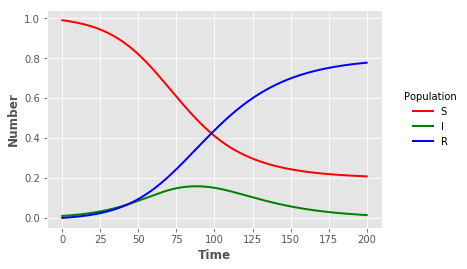Python using scipy
Author: Simon Frost
Date: 2018-07-12
import numpy as np
import pandas as pd
from scipy.integrate import ode, solve_ivp
def sir_ode(times,init,parms):
b, g = parms
S,I,R = init
# ODEs
dS = -b*S*I
dI = b*S*I-g*I
dR = g*I
return [dS,dI,dR]
parms = [0.1,0.05]
init = [0.99,0.01,0]
times = np.linspace(0,200,2001)
sir_sol = solve_ivp(fun=lambda t, y: sir_ode(t, y, parms), t_span=[min(times),max(times)], y0=init, t_eval=times)
sir_out = pd.DataFrame({"t":sir_sol["t"],"S":sir_sol["y"][0],"I":sir_sol["y"][1],"R":sir_sol["y"][2]})
Visualisation
import matplotlib.pyplot as plt
plt.style.use("ggplot")
sline = plt.plot("t","S","",data=sir_out,color="red",linewidth=2)
iline = plt.plot("t","I","",data=sir_out,color="green",linewidth=2)
rline = plt.plot("t","R","",data=sir_out,color="blue",linewidth=2)
plt.xlabel("Time",fontweight="bold")
plt.ylabel("Number",fontweight="bold")
legend = plt.legend(title="Population",loc=5,bbox_to_anchor=(1.25,0.5))
frame = legend.get_frame()
frame.set_facecolor("white")
frame.set_linewidth(0)

